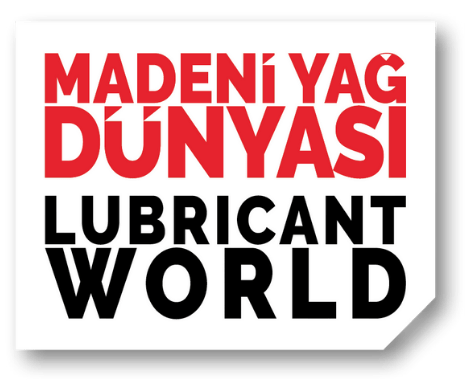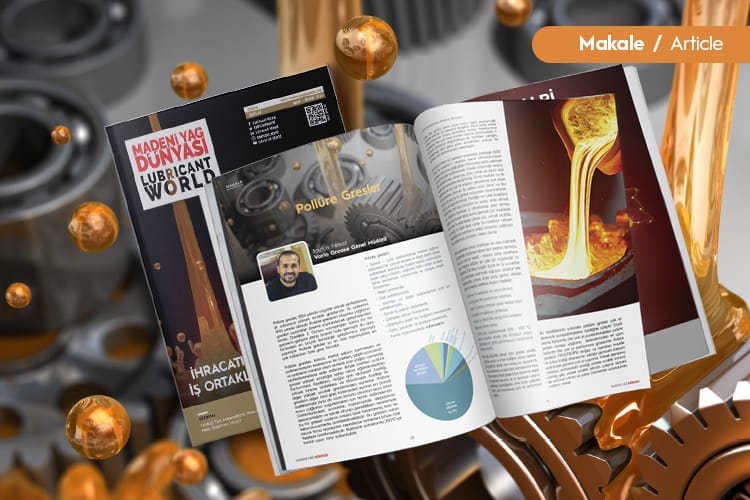Polyurea (PU) greases were the first soap-free high-temperature greases, synthesized organically in 1824. It received the first patent in 1955. The formation of polyurea greases is one of the developments that can be considered important in terms of lubricating greases. Especially after World War II, the development of this type of greases became more important. Japan made the biggest technological development in this type of grease. Even now polyurea greases are the most widely used type of specialty grease in Japan.
Polyurea greases are ash-free, metal soap-free and produced by polymerization reaction, and are obtained by synthesizing various isocyanates and amines in mineral or synthetic base oils. Polyurea greases produced in this way tend to have high temperatures. They differ from other high temperature greases with their performance properties, natural anti-oxidative properties, high shear stability and thixotropic properties. One of the most important features of polyurea greases that distinguish them from other special grease types is that they are long-lasting or preferred for lifetime lubrication applications.
Due to the difficulties in their production, raw material storage disadvantages and technical infrastructure requirements, these types of greases can only be produced in specially designed facilities and laboratories. Many companies selling these greases have almost all of their products produced in such special facilities.
As for the application areas of these greases, they can be used in rolling bearings for long periods of time up to 200°C.
Other applications of polyurea greases include:
- In the iron and steel industry with centralized lubrication systems and high temperature and low speed rolling bearings, particularly rolling mills, continuous casting line exit rolls, cooling line rolls and heating furnace conveyor rolls and walking hearth furnaces,
- In pellet presses,
- In fan bearings,
- In hot rolling bearings of cardboard and paper machines,
- In systems working at high temperatures,
- In cement rotary kilns,
- In automotive constant velocity joint components,
- In glass, ceramic and bottling facilities,
- In agricultural machinery.

Polyurea Greases in the Steel Industry
Steel is not an element in the periodic table like gold, silver, iron or copper. So, if we want to obtain steel, we must definitely include the human factor. So how is steel produced? New performances can be added by changing the molecular structure of the steel produced by changing the C (carbon) ratios of the iron, depending on where it will be used. The heat energy required for these performances is approximately 1500 ⁰C. At this temperature, C atoms separate from iron atoms, resulting in liquid steel.
Approximately 1 billion tons of steel are produced annually in the world. In continuous casting, molten steel is transformed into intermediate products called slabs, billets and blooms with the help of blast furnaces. It is the process of converting molten metal into a solid phase by passing it through a water-cooled, open-ended mold. This mold is called the permanent mold and it consists of two interlocking parts. The mold is cooled with water. For example, when liquid steel is poured into molds, water is rotated around the molds to form a smooth surface. These products are then sent to the rolling mill for processing. These systems have high load, high temperature, presence of water and low speed. These properties cause difficulties in creating a lubricant film between the bearing rollers and surfaces.
It is very important to minimize bearing failures in the steel industry. A defective bearing means both a halt of production and financial and emotional damage to the manufacturer. The amount of water applied for liquid steel poured into molds can reach 3750 liters per minute. Even very well-sealed bearings have difficulty withstanding such water force. The main features expected from greases operating under such harsh conditions are:
- Minimizes friction and wear,
- Prevents corrosion even in the presence of water,
- Does not react with passive and non-corrosive bearing materials and metals,
- Continues to lubricate the bearing without leaving it, even under pressurized water,
- Continues to maintain its first day performance without deteriorating its chemical structure even under operating conditions at production process temperatures (800 – 1000 ⁰C).
Greases with high base oil viscosity are constantly exposed to cooling water and ambient contamination. Greases under these conditions must both resist corrosion and be neutral towards elastomers and sealing elements. Since polyurea greases show good working performance with many elastomer types and sealing elements, they provide strong performance in bearing elements where lifelong lubrication is required. In addition to these properties, polyurea greases have very good pumpability. Polyurea greases, which can be pumped very well even at low shear speeds, perform very well even on the longest lines in centralized lubrication systems. The THIXOTROPIC nature of polyurea greases makes them very good at sealing, preventing water, corrosive substances and ambient contamination elements from entering the bearing. Their high dropping points and antioxidative properties not only prolong high temperature life, but also help extend the life of rollers and bearings by prolonging operating time under high temperatures.
Polyurea Greases in Agricultural Vehicles
One of the outstanding properties of polyurea greases is that they tend to thicken as temperature increases. This feature helps bearings operate under high temperatures for long periods of time. The fact that the greases do not contain metals that will catalyze oxidation means the grease has longer working capability and longer and safer bearing life. Due to these features, they have recently started to be used frequently in agricultural vehicles. JOHN DEERE started to use polyurea greases as the first-fill when producing its agricultural vehicles.
This type of grease has begun to be used especially for the lubrication of heavily loaded ball and roller bearings, steering boxes and bearings, U-joints, pins and bushings of cotton, wheat and corn harvester vehicles. They are especially preferred in the gear mechanisms of these vehicles. Since it is thicker than oil, it does not leak from the gears even when the machine is not working, thus maintaining its normal consistency and acting as a seal.
In addition to all these, metals have a catalytic effect on oxidation. This feature accelerates and increases the deterioration of grease lubricants. Since polyurea-based greases do not contain metal in soap formation, they are highly resistant to oxidation and their working life is longer than metal soap greases.
High temperature behavior and working life of polyurea greases are also very good. Especially in high temperature life analyses, polyurea greases offer up to 50% longer working life than other types of high temperature greases. With this feature, it reduces maintenance costs by contributing to the life of bearings operating at high speed and high temperature.
Polyurea Greases in Automotive Industry
Automotive constant velocity joints are used to smoothly transmit the energy from the transmission output shaft to the wheels. Nowadays, large amounts of grease are used to lubricate such connections. The main purpose of using polyurea greases in these systems is to use the vehicles throughout their lifetime without the need for re-lubrication. These systems are very complex systems if considered from a tribological perspective. In the most aggressive cases, the temperature can reach 180 °C. In vehicle systems that reach these temperature levels, polyurea greases are frequently preferred due to their high dropping point, oxidative resistance and non-soot-forming structure.
One of the strongest aspects of polyurea greases in these systems is their THIXOTROPIC property. In other words, greases, by their nature, tend to soften structurally after a certain amount of physical use. However, since the thixotropic structure of polyurea greases is strong, when the vehicle is stopped and not used for a certain period of time, the grease in it regains its initial consistency and continues to work.

Tayfun Yılmaz
Vario Grease General Manager




